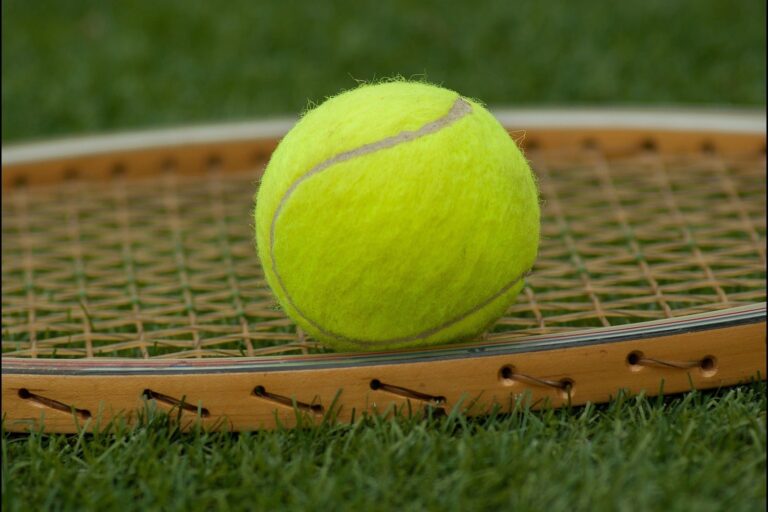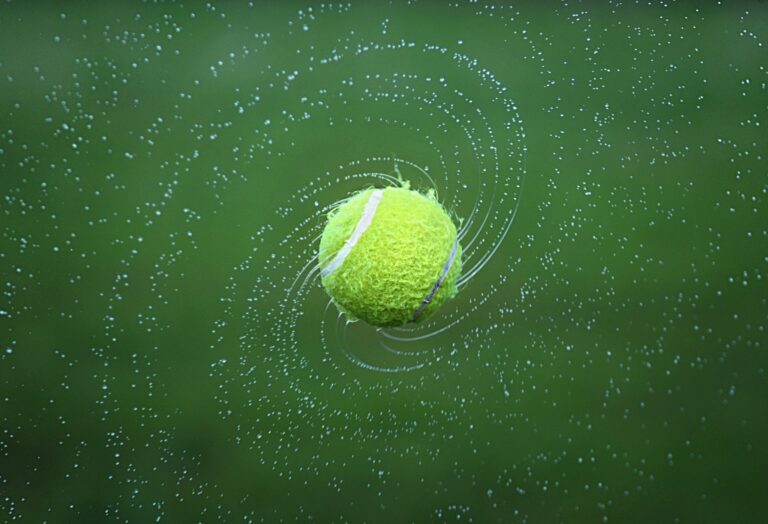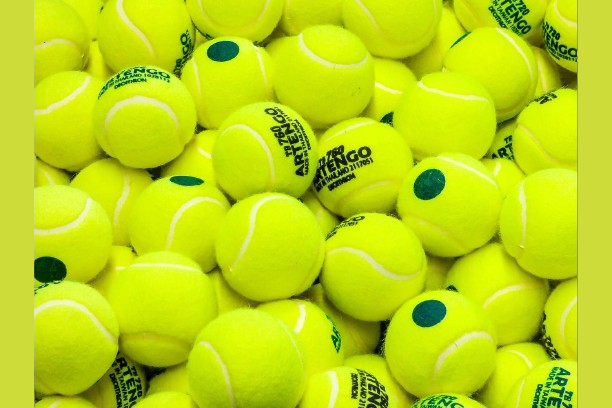It is a common question, What Color Are Tennis Balls? According to the International Federation of Tennis, tennis balls are yellow colored. Players’ perceptions of a tennis ball are so fixed that they cannot imagine anything else. Is there a formal term for tennis ball colors, even though most people call it “tennis ball yellow”? We can say it is an Optic yellow ball. Many players ask What Color Are Tennis Balls exactly. Examining the evolution of tennis ball color, we provide answers and other queries.
Do you know What Color Are Tennis Balls? If you don’t know join us till the end. This blog post will provide you with complete information. Optic yellow is the official color for the hue of tennis balls. Because it is an electric lime or brilliant yellow, people are unsure if it is green or yellow. Everything is available in this guide, including recommendations for the best-colored balls.
Tennis balls’ color has changed over time to aid in visibility as well discussed in this blog. There is much discussion about whether they should be green or yellow. For children 10 years old and younger who are learning to play tennis are different colors. These colors can aid in differentiating between different game levels. Beyond their use on the tennis court, colorful tennis balls have a variety of useful balls. But sometimes surprising uses, such as washing, chairs, walkers, and well-liked pet toys.
Table of Contents
ToggleHistory of Tennis Ball Color
Many new players are often surprised to learn the original tennis ball color. And the best ball to use depended on the color of the background of the court. To improve visibility on television, the IFT optic yellow tennis balls in 1972. IFT implemented this change in most professional tennis competitions.
It’s interesting to note that although tennis balls are black and white. This wasn’t a problem until color TVs became more used. This made it harder for onlookers to see the ball. But, rooted in tradition, Wimbledon resisted the shift to yellow tennis balls in 1986. It’s difficult to picture tennis balls not being yellow these days.
What Color Are Tennis Balls?
This is an explanation of the various tennis ball colors and their functions.For the player’s height and skills, the red, orange, and green balls are often designed. These balls travel through the air lower and bounce lower.
IFT designated optic yellow or yellow color for international competitions. But there are some other colors of balls used in tennis.
1-Yellow tennis balls
Because yellow tennis balls were easier for television viewers to see. As before noted by research, the ITF included yellow balls in the game in 1972.
This unique ball color by the ITF is “optic yellow.” We can denote this color as “Electric lime or fluorescent yellow”. These balls have the hexadecimal code #ccff00.
Although there is a narrow, fuzzy line separating yellow and green. Two colors that are similar enough to cause endless arguments over their true colors.

2- White tennis balls
Balls were either black or white, depending on the color of the courts’ backdrop. Wimbledon continued to the white ball until 1986 when they switched to yellow balls.
3- Red / Red and White tennis balls
The term “red tennis” originated from the red foam or felt balls that are now in use. Due to lower bounce and air motion, this color gives beginners a chance to set themselves. Courts are 36 feet long and 18 feet wide with a 2 feet 9 inches net. 78 feet by 27 feet for singles and 78 feet by 36 feet for doubles with a 3.5-foot.
There is a good chance for beginners to take position and a decent swing at the ball. Since this color ball bounces lower and does not move fast through the air.

4- Orange tennis balls
After confident play experience at the red level players should choose a red ball. Compared to red balls, orange-felt balls move more fast and bounce higher. The next level, green ball play, moves even more fast.
These balls are different from standard yellow tennis balls. But still enjoyable and playable for beginners. For single and double play, the courts measure 60′ by 21′ and 60′ by 27′. The net is at regulation height.

5- Green tennis balls
The green ball has a lower compression than the traditional yellow tennis ball. It still resembles the yellow ball quite a bit and bounces off the court.
Also to use the usual net height, the green court’s dimensions are 78 by 27 feet.

The Official Color of the ITF Tennis Ball
Tennis balls were first made of white color. This color scheme persisted until the introduction of color television in 1972. Since the popularity of tennis was growing and new technologies were available. ITF set out to make sure that its balls were only created in a color that was easy to see.
They conducted many tests before settling on the now-iconic optic golden hue. The audience’s ability to view the ball on a color TV screen was the main goal. The high chroma, or vivid hues that don’t have a trace of gray or white.
Tennis balls Color Code
The tennis ball color code is ccff00 on ColorHexa, an online encyclopedia of color. This is the most popular method for choosing a color scheme. If you want to be certain about the precise color code you consult.
Details on tennis ball's color
The code is dfff4f based on the HexaColor scheme that ITF employs. Hex is a system that grades a mix-up of colors of blue, green, and red. A tennis ball is either fluorescent yellow or electric lime in the Hexagon
The tennis ball color is most ranked among the green hues using the RBG coding scheme. The color 223,255,79 is the RBG code.
Tennis ball for Recreation and Professional
The distinction between professional and recreational tennis balls is clear color.
- Professional tennis balls consist of combustible materials, which give a bright yellow color. They are for consistent play and performance.
- Because of its striking color, players will find it simpler to locate during a game.
- Recreational tennis balls come in different colors, such as pink, orange, or green.
- Made of plastic or foam, these colored balls are non-flammable materials.
- They may not perform as well as professional balls and are less durable.
- They are, still, cheap and make excellent choices for leisure gaming.
- It’s crucial to remember that all professional and international competitions use yellow balls. They use these official regulations of the International Tennis Federation (ITF).
- This is to guarantee that every player has an equal playing experience. And to stop any player from benefiting from the color of the ball.
- To maintain fairness, yellow balls are for a lot of recreation and competitions.
Colors of Professional tennis balls
The colors of professional tennis can change according to the competition. Tennis balls are yellow, yet green and white balls are also used in competitions. Since they have contrasted more visible with the clay court surface. Green tennis balls are most used in clay court competitions.This makes it easier for players to follow the ball throughout the game.
Indoor tennis competitions use white tennis balls. These may constructed with a unique felt to increase ball speed and accuracy. Professional tennis balls come in a variety of colors. Color affects the ball’s performance besides visibility during play.
Yellow tennis ball
Yellow balls are a major use of professional competitions. The rubber substance undergoes a chemical reaction giving rise to a yellow color.
Players can better track the ball during a match thanks to the yellow colors. This color can lessen the glare the ball receives from the sun. Professional tennis balls’ colors have an impact on performance. Because of its distinct qualities, every color of a tennis ball is better suited for a certain court.
For instance, yellow tennis balls are more appropriate for hard courts. Because they are less impacted by the surface and have a more even bounce.
Green tennis ball
Since green tennis balls contrast more with the clay court surface. So they are more utilized in clay court tournaments.
This makes it easier for players to follow the ball throughout the game.
White tennis ball
Indoor tennis competitions use white tennis balls. These are often constructed with a unique felt material to aid reduce air resistance.
Subjectivity in Visual Perception
Although our perception of color is always personal, some colors are universal. Tennis balls are either yellow or green, but oranges are always orange.
The Difficulty of Describing Yellow
Pure Yellow might be difficult to describe. When compared to other colors (think paint swatches). It’s simple to recognize, but it’s more difficult to explain when there are no other colors.
Color Adjustments Depending on Lighting
Individuals change their color perception in response to changes in lighting. If warm hues, like gold, are most disregarded, the ball may appear yellow. Green is more prevalent if cool hues like blue are often discounted.
Conclusion
In conclusion, we can say that tennis balls have different colors. But the most useful colors are yellow and green. It is a common question, What Color Are Tennis Balls? According to the International Federation of Tennis, tennis balls are yellow colored. As before noted by research, the ITF included yellow balls in the game in 1972. This unique ball color is famous by the ITF as “optic yellow.” We can donate the color as “Electric lime or fluorescent yellow”. These balls have the hexadecimal code #ccff00. Yellow balls are a major use of professional competitions.
What Color Are Tennis Balls? It is not difficult to understand. There is a complete detail of this question like its color and code. The tennis ball color code is ccff00 on ColorHexa, an online encyclopedia of color. The green ball has a lower compression than the traditional yellow tennis ball. Red balls have lower bounce and air motion, this color gives beginners a chance to set. Beyond their use on the tennis court, colorful tennis balls have a variety of useful balls. But sometimes surprising uses, such as washing, chairs, walkers, and well-liked pet toys.
FAQs
Which tennis ball colors are generally accepted?
The majority of balls produced now have an optical yellow fluorescent color. This was first accepted in 1972 after tests showed they were more visible on television. The ITF only accepts the colors yellow and white.
Why Are the Felt wraps used on tennis balls?
Tennis balls are air-filled and have a rubber composite surface coated with felt. The felt reduces aerodynamic drag by preventing flow separation in the boundary layer. It enhances the ball’s flying qualities.
How Does a tennis ball's number signify something?
A number is usually printed on tennis balls also to the brand name. This facilitates distinguishing between balls and another of the same brand.
What Color Are Tennis Balls usually accepted?
The optical yellow fluorescent tint was first approved in 1972. Testing showed they were more visible on television and seen on most produced balls. The only colors accepted by the ITF are white and yellow.
What does the number on a tennis ball mean?
Tennis balls have a number printed on them also to the brand name. This makes it easier to tell one set of balls apart from another of the same brand.
Why do tennis learners use various color balls?
The slowest balls are larger, unpressurized, composed of foam rubber, and half-red felt. The balls below are regular-sized, unpressurized balls; they are orange-colored. Under half pressure, the last green ones are typical in size.

